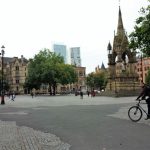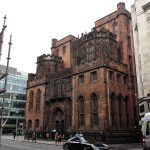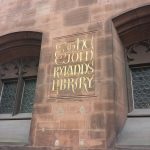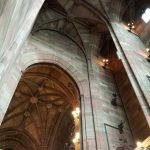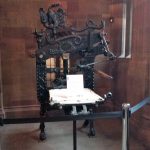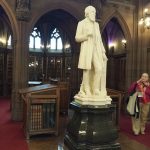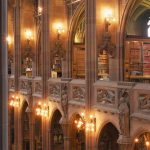Going Abroad to attend a conference includes getting to see places related to its purpose. In this case, the 2016 Annual International Conference for Paragone Studies took place in Manchester, in the northwest part of England, said to be the world’s first industrial city. Activities included in the trip were planned to interest art historians, so of course on Excursion Day the participants were offered the option of accompanying us to visit John Rylands Library as our first stop.
Just a short walking distance from our hotel, we set out in the city center. What I noticed and admired was the fact that people do much more walking here. Stopping at some of the corners in order to cross a street, words are written on the ground around the curve of the corner that say, “Look Left,” or, ”Look Right,” indicating the direction of potential oncoming one-way traffic. On the sidewalks next to many of the buildings were worn glass tiles from which you could discern light showing through to lower levels of the buildings. It added to the charm of the architecture that very closely resembled the Harry Potter movies.
I was curious why a library was on our list of places to see among the art museums. It stood in stark contrast next to a very modern-looking building. It was charming, though it did not stand out to me among the various time periods represented in this cityscape. However, as soon as we stepped inside, I knew exactly why we were here. The John Rylands Library is said to be one of the finest libraries in the world and best example of neo-Gothic architecture in Europe. Taking ten years to build, according to the design by architect Basil Champneys (1842-1935), the library was a tribute by Mrs. Rylands to her late husband John Rylands who was Manchester’s first textile millionaire.
Although all of the bookshelves are encased under glass with Art-Nouveau locks, a style amidst the Victorian Gothic, this is very much a working library. Researches from all over the world can easily gain access to the books and items in the collection that spans 5000 years from all corners of the world. One of the art historians from the conference, as a matter of fact, made use of the opportunity to stay behind during this stop on our excursion to see a book for research. I made a mental note for future reference that these professional scholars make use of all opportunities to research, view and photograph items relevant to their work, including during conference trips. Why not?
The original Entrance Hall contains a group of statues called, Theology directing the labours of Science and Art by Irish sculptor John Cassidy (1860-1939), who also created the sculptures of John Rylands himself overlooking the Historic Reading Room and Mrs. Rylands from the opposite end. The stained glass windows and numerous sculptures aligning the reading room, draw from theology, literature, the arts and science, as a fitting tribute to those individuals who have contributed to human knowledge. Every inch of the building and its contents reflect the beauty of the period, well-known for its florid ornamentation. It was an exceptionally beautiful place for one to be immersed in the atmosphere of another time while researching from primary sources.
After perusing the library, I gathered the conference participants and led them outside to meet our taxi’s for our next stop on this Excursion Day. I think now of why should this matter to the students at UM-Flint? Maybe the best way to put it is: Education Abroad makes things more real than you can get out of books or the internet. When you can actually see the scale of something surrounding you, when you can touch it, move through it and take it in as a whole…it begins to broaden possibilities.
It’s time to start thinking about what you are studying and how you can gain experience from going abroad for a conference, or for an academic program. Yes, it enhances your studies, but it also allows you to experience another culture in the day-to-day and with this comes meeting new people. You are going to meet people who share your interests and passions, people beneficial to you professionally and people who may become lifelong friends. Go for it.
Sources
The John Rylands Library -Visitor Information, University of Manchester, Deansgate, Manchester, UK, 2016.
http://www.library.manchester.ac.uk/rylands/
http://www.library.manchester.ac.uk/rylands/our-history/
http://www.library.manchester.ac.uk/rylands/our-history/the-building/
http://www.library.manchester.ac.uk/rylands/our-history/the-collections/
http://www.johncassidy.org.uk/theology.html
*Some images in this blogpost are designated from (c) 2016 The University of Manchester, all rights reserved. All others images are courtesy of the author.
Links
https://www.facebook.com/JohnRylandsLibrary/?fref=ts
https://www.instagram.com/thejohnrylands/
https://twitter.com/search?q=The%20John%20Rylands&src=typd
Coming Soon! Next stop in the Conference Abroad Series- #3: The Monastery in Gorton.

